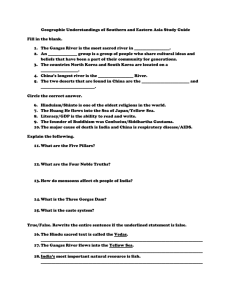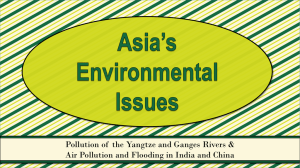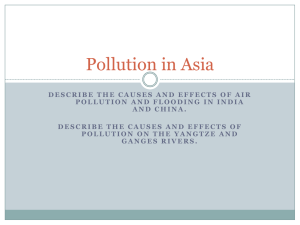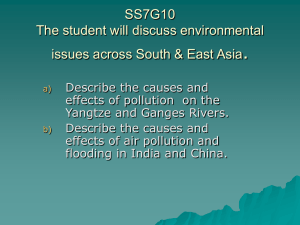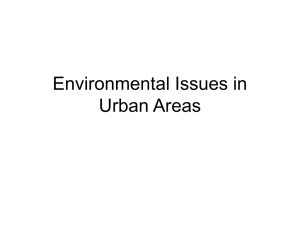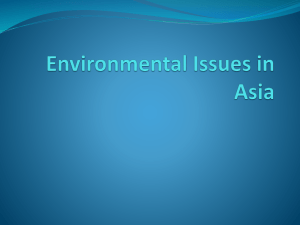South & East Asia Environmental Issues
advertisement
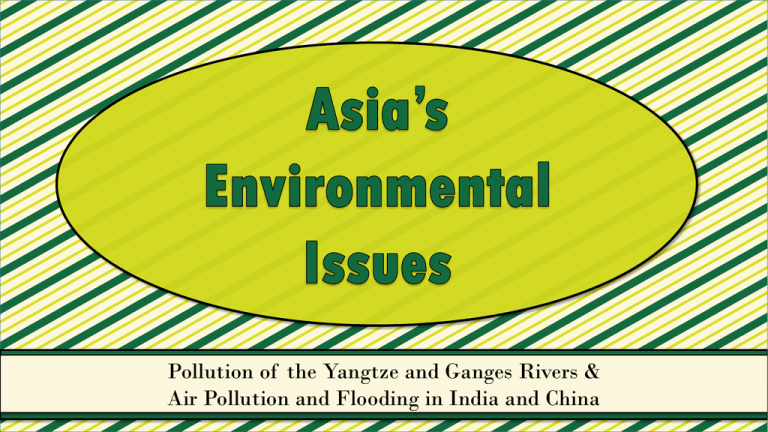
Pollution of the Yangtze and Ganges Rivers & Air Pollution and Flooding in India and China Standards SS7G10 The student will discuss environmental issues across Southern and Eastern Asia. a. Describe the causes and effects of pollution on the Yangtze and Ganges Rivers. b. Describe the causes and effects of air pollution and flooding in India and and China. fdsafs • The Ganges River begins high in the Himalayas and flows southeast through India and Bangladesh for more than 1,500 miles to the Bay of Bengal. • It is the most important river to the Indian subcontinent. • The Ganges provides water for drinking, bathing, cooking, and for transportation for over 400 million people who live in its river valley. • It runs through India’s most fertile and densely populated areas. • The Ganges is nicknamed “Mother Ganges”, and it is very sacred to the Hindu religion. fdsafs • About two million tons of chemical, human, and agricultural waste pours into the Ganges every day. • Cities pour millions of gallons of sewage into the river that is eventually carried to villages farther south. • Human and animal waste also pollute the river. • Hindus believe that they will have a peaceful journey to the next life if their ashes are scattered into the Ganges. • Many are too poor for cremation, so they place the bodies in the water instead. fdsafs • The Ganges River is highly polluted with dangerous bacteria. • Causes diseases and death among the people • It is estimated that about 80% of all illnesses and 1/3rd of deaths in India come from diseases carried by dirty water. • Outbreaks of such diseases as cholera, dysentery, typhoid, and hepatitis are common. • Cities along the Ganges have the highest rates of waterborn diseases (found in drinking water) of any who live in India. • India’s government started a program in 1985 called the Ganges Action Plan, with the purpose of cleaning up the river. • Indians have built many sewage and water treatment plants along the river. • Unfortunately, it has not proved to be enough as India’s growing population and the run-off from industrial and farm production have continued to pollute the river. fdsafs • The Yangtze is China’s longest river and the third longest in the world. • It begins in the Tibetan Plateau and flows nearly 4,000 miles through 185 towns where 400 million people live until it reaches the East China Sea. • The Yangtze is extremely important to about a third of China’s population because it provides hydroelectric power, water for irrigation, and transportation for cargo ships. • Pumping stations along the river take water out to supply people with water for drinking, irrigation, and industrial uses. Yangtze in Shanghai • Main cause of pollution is chemical waste from agriculture and industry: • Billions of tons of chemicals and waste from agriculture, industry, and humans pour into the river each year. • Nitrogen from fertilizers and arsenic (poisonous chemical) from industrial uses are the leading pollutants in the river. fdsafs • The pollution puts all of the cities along its banks at risk. • Many species of plants and animals are dying. • Nitrates from farm run-off has caused algae in the water to multiply and is contaminating and killing the fish. • Disease or illness among the people • Chinese people are eating the sick fish, which has led to many health problems. • Hundreds of millions of Chinese villagers do not have safe drinking water because of the pollution. • The Chinese government is building more water treatment facilities along the Yangtze’s banks. • It is encouraging cities to build sanitary landfills for garbage rather than dumping it into the river. • Monsoons are a mixed blessing for India. • Farmers depend on the rain for their crops and the huge amounts of water are used to generate electricity. • Unfortunately, monsoons are also responsible for heavy floods. • Monsoon season begins in June and spreads heavy rain until September. • If flooding occurs, the rivers overflow and cause mass destruction and spread water-borne diseases. fdsafs • When monsoons are too severe, the rivers overflow their banks and water sweeps over the land. • When this happens, airports close, power lines fall, humans and animals drown, and waterborne illnesses spread. • Monsoons are beneficial to farmers, but they also cause floods in China. • China’s monsoon season runs from March through August. • Over the years, loggers have cut down many of the trees that used to contain flooding. • Farmers downstream have also drained wetlands that used to act as sponges during floods. • These actions have multiplied the effects of the storm water runoff and it now takes much less water to cause a flood. fdsafs • Monsoons usually cause floods every two or three years in China. • When the river floods, homes and crops are buried and lives are lost. • Flooding from China’s Huang He River has caused more deaths than any other river in the world. fdsafs • India has some of the heaviest air pollution in the world due to an enormous and automobile emissions and the development of industry. • Automobile emissions account for almost 70% of the air pollution in some urban areas of India. • Indoor air pollution is also a growing problem. • In rural areas, many families cook over open fires, using wood, livestock dung, or coal as fuel. • These fuel sources emit carbon monoxide, soot, and other harmful chemicals into the air. “Cooking fuel in rural India is prepared from a wet mix of dried grass, fuelwood pieces, hay, leaves and mostly cow/livestock dung. This mix is patted down into disc-shaped cakes, dried, and then used as fuel in stoves. When it burns, it produces smoke and numerous indoor air pollutants at concentrations 5 times higher than coal.” • Because of India’s rapidly growing population, more and more Indians are exposed to pollution every year. • Indians living in cities have some of the highest rates of respiratory disease in the world. • Air pollution is now the fifth leading cause of death in India. • The Taj Mahal, a sacred site and popular tourist destination, is growing yellow from high levels of air pollution. • Some scientists believe that Indian smog could potentially change weather patterns in North America. • It has been very difficult for India’s government to enforce laws on industry and transportation to clean up the air because it would effect the economy. • A large part of India’s population is poor and does not want anything to slow down economic growth. • India has been investing money in clean up efforts, but it has not proved to be enough. • China’s cities have experienced tremendous growth in population and industry in the past few decades. • China is home to 16 of the world’s 20 most polluted cities. • Much of China’s energy is provided by burning coal, a process that sends soot, ash, and chemicals into the air. • The Chinese people also burn coal to heat their homes, adding to the pollution problem. • Millions of Chinese people now drive automobiles, whose exhaust is a major source of air pollution. fdsafs • The leading causes of death in China are heart and respiratory conditions related to overexposure to air pollution. • Air pollution has also created acid rain in China, a problem for at least a third of country’s agricultural areas. • Unfortunately, air pollution created in Chinese cities is not confined in the country. • Winds carry the contaminated air and rain to Korea, Japan, and other parts of Asia as well. fdsafs • China’s government created the Beijing Municipal Environmental Protection Bureau to work on the quality of the city’s air before the 2008 Olympics. • Automobile traffic was greatly reduced and many factories were temporarily closed. • Many air pollutants were cut by as much as 45%. • Many people enjoyed the cleaner air and petitioned the government to find long-term ways to clean it up.

